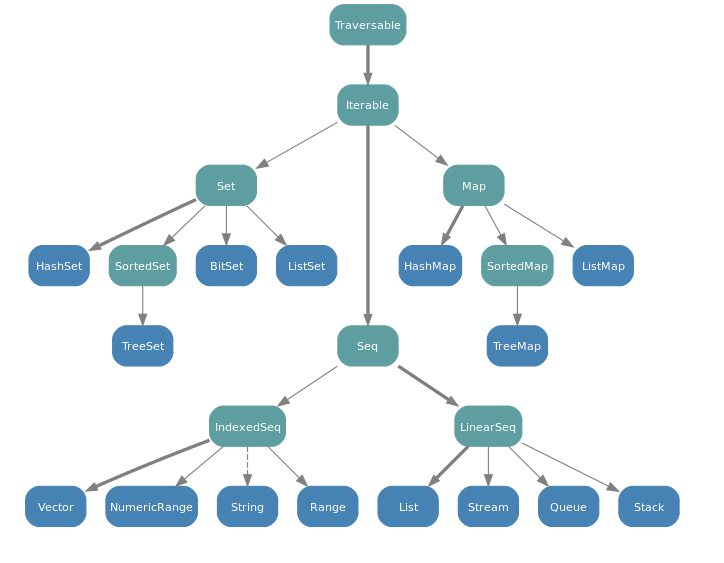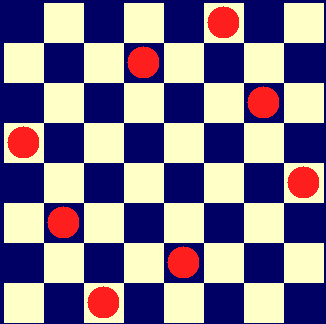

Copyright © Cay S. Horstmann 2015 
This work is licensed under a Creative Commons Attribution 4.0 International License
We can extend the usage of higher order functions on sequences to many
calculations which are usually expressed using nested loops.
Example: Given a positive integer n, find all pairs of positive integers i and j, with 1 <= j < i < n such that i + j is prime.
For example, if n = 7, the sought pairs are

A natural way to do this is to:
(i, j) such that 1 <= j < i < n.i + j is prime.One natural way to generate the sequence of pairs is to:
i between 1 and n (excluded).i, generate the list of pairs (i, 1), ..., (i, i-1).This can be achieved by combining until and map:
(1 until n) map (i =>
(1 until i) map (j => (i, j)))What is the type of the result?
(1 until n) map (i =>
(1 until i) map (j => (i, j)))
The previous step gave a sequence of sequences, let's call it xss.
We can combine all the sub-sequences using foldRight with ++:
(xss foldRight Seq[Int]())(_ ++ _)Or, equivalently, we use the built-in method flatten
xss.flattenThis gives:
((1 until n) map (i =>
(1 until i) map (j => (i, j)))).flattenHere's a useful law:
xs flatMap f = (xs map f).flattenHence, the above expression can be simplified to
(1 until n) flatMap (i =>
(1 until i) map (j => (i, j)))By reassembling the pieces, we obtain the following expression:
(1 until n) flatMap (i =>
(1 until i) map (j => (i, j))) filter ( pair =>
isPrime(pair._1 + pair._2))This works, but makes most people's head hurt.
Is there a simpler way?
Higher-order functions such as map, flatMap or filter provide powerful constructs for manipulating lists.
But sometimes the level of abstraction required by these function make the program difficult to understand.
In this case, Scala's for expression notation can help.
Let persons be a list of elements of class Person, with fields name and age.
case class Person(name: String, age: Int)To obtain the names of persons over 20 years old, you can write:
for ( p <- persons if p.age > 20 ) yield p.namewhich is equivalent to:
persons filter (p => p.age > 20) map (p => p.name)The for-expression is similar to loops in imperative languages, except
that it builds a list of the results of all iterations.
A for-expression is of the form
for ( s ) yield ewhere s is a sequence of generators and filters,
and e is an expression whose value is returned by an iteration.
p <- e, p is a pattern and e an expression whose value is a collection. if f where f is a boolean expression.Instead of ( s ), braces { s } can also be used, and then the
sequence of generators and filters can be written on multiple lines
without requiring semicolons.
Here are two examples which were previously solved with higher-order functions:
Given a positive integer n, find all the pairs of positive integers
(i, j) such that 1 <= j < i < n, and i + j is prime.
for {
i <- 1 until n
j <- 1 until i
if isPrime(i + j)
} yield (i, j)Write a version of scalarProduct (see last session) that makes use of
a for:
def scalarProduct(xs: List[Double], ys: List[Double]) : Double =In the following we are going to see Sets which are another fundamental collection type.
We then combine Sets and For Expressions in a classical combinatorial search problem, namely the N-Queens problem.
Sets are another basic abstraction in the Scala collections.
So far, all the collections we have seen were sequences. But there are also two other two other fundamental class of collections: Setsand Maps
A set is written analogously to a sequence:
val fruit = Set("apple", "banana", "pear")
//> fruit : scala.collection.immutable.Set[String] = Set(apple, banana, pear)
val s = (1 to 6).toSet
//> s : scala.collection.immutable.Set[Int] = Set(5, 1, 6, 2, 3, 4)Most operations on sequences are also available on sets:
s map (_ + 2)
//> res1: scala.collection.immutable.Set[Int] = Set(5, 6, 7, 3, 8, 4)
fruit filter (_.startsWith("app"))
//> res2: scala.collection.immutable.Set[String] = Set(apple)
s.nonEmpty
//> res3: Boolean = true(see Iterables Scaladoc for a list of all supported operations)
The principal differences between sets and sequences are:
Sets are unordered; the elements of a set do not have a predefined order in which they appear in the set
sets do not have duplicate elements:
s map (_ / 2) // Set(2, 0, 3, 1) The fundamental operation on sets is contains:
s contains 5 // trueThe eight queens problem is to place eight queens on a chessboard so that no queen is threatened by another.

In other words, there can’t be two queens in the same row, column, or diagonal.
We now develop a solution for a chessboard of any size, not just 8.
One way to solve the problem is to place a queen on each row.
Once we have placed k - 1 queens, one must place the kth queen in a column where it’s not “in check” with any other queen on the board.
We can solve this problem with a recursive algorithm:
k-1 queens on a board of size n.k-1) containing the numbers of columns (between 0 and n-1).k-1th row comes first in the list, followed by the column number of the queen in row k-2, etc. kth queen, we generate all possible extensions of each solution preceded by a new queen: def queens(n: Int) = {
def placeQueens(k: Int): Set[List[Int]] = {
if (k == 0) Set(List())
else
for {
queens <- placeQueens(k - 1)
col <- 0 until n
if isSafe(col, queens)
} yield col :: queens
}
placeQueens(n)
}Write a function
def isSafe(col: Int, queens: List[Int]): Booleanwhich tests if a queen placed in an indicated column col is secure amongst the other placed queens.
It is assumed that the new queen is placed in the next availabale row after the other placed queens (in other words: in row queens.length).
Steps:
queens list, the new queen given by col is not in check:forThe for notation is essentially equivalent to the common operations of
query languages for databases.
Example: Suppose that we have a database books, represented as a list of books.
case class Book(title: String, authors: List[String]) val books: List[Book] = List(
Book(title = "Structure and Interpretation of Computer Programs",
authors = List("Abelson, Harald", "Sussman, Gerald J.")),
Book(title = "Introduction to Functional Programming",
authors = List("Bird, Richard", "Wadler, Phil")),
Book(title = "Effective Java",
authors = List("Bloch, Joshua")),
Book(title = "Java Puzzlers",
authors = List("Bloch, Joshua", "Gafter, Neal")),
Book(title = "Programming in Scala",
authors = List("Odersky, Martin", "Spoon, Lex", "Venners, Bill")))To find the titles of books whose author’s name is “Bird”:
for (b <- books; a <- b.authors if a startsWith "Bird,")
yield b.titleTo find all the books which have the word “Program” in the title:
for (b <- books if b.title indexOf "Program" >= 0)
yield b.titleTo find the names of all authors who have written at least two books present in the database.
for {
b1 <- books
b2 <- books
if b1 != b2
a1 <- b1.authors
a2 <- b2.authors
if a1 == a2
} yield a1Why do solutions show up twice?
How can we avoid this?
To find the names of all authors who have written at least two books present in the database.
for {
b1 <- books
b2 <- books
if b1.title < b2.title
a1 <- b1.authors
a2 <- b2.authors
if a1 == a2
} yield a1What happens if an author has published three books?
Another possibility is to use the operation withDefaultValue that turns a map into a
total function:
val cap1 = capitalOfCountry withDefaultValue "<unknown>"
cap1("Andorra") // "<unknown>"You can take look at different operations in class Map here.
Two useful operation of SQL queries in addition to for-expressions are
groupBy and orderBy.
orderBy on a collection can be expressed by sortWith and sorted.
val fruit = List("apple", "pear", "orange", "pineapple")
fruit sortWith (_.length < _.length) // List("pear", "apple", "orange", "pineapple")
fruit.sorted // List("apple", "orange", "pear", "pineapple")groupBy is available on Scala collections. It partitions a collection
into a map of collections according to a discriminator function f.
Example:
fruit groupBy (_.head) //> Map(p -> List(pear, pineapple),
//| a -> List(apple),
//| o -> List(orange))A polynomial can be seen as a map from exponents to coefficients.
For instance, can be represented with the map.
Map(0 -> 5, 1 -> -2, 3 -> 1)Based on this observation, let’s design a class Polynom that represents polynomials as maps.
class Poly(val terms0: Map[Int, Double]) {
val terms = terms0 withDefaultValue 0.0
def + (other: Poly) : Poly = {
val newKeySet = terms.keySet ++ other.terms.keySet
val setOfTuples = for(x <- newKeySet) yield
( x -> (terms(x) + other.terms(x)))
new Poly(setOfTuples.toMap)
}
}It’s quite inconvenient to have to write
Polynom(Map(1 -> 2.0, 3 -> 4.0, 5 -> 6.2))Can one do without the Map(...)?
Problem: The number of key -> value pairs passed to Map can vary.
We can accommodate this pattern using a repeated parameter:
def Polynom(bindings: (Int, Double)*) =
new Polynom(bindings.toMap withDefaultValue 0)
Polynom(1 -> 2.0, 3 -> 4.0, 5 -> 6.2)Inside the Polynom function, bindings is seen as a
Seq[(Int, Double)].
class Poly(val terms0: Map[Int, Double]) {
def this(bindings: (Int, Double)*) = this(bindings.toMap)
val terms = terms0 withDefaultValue 0.0
def + (other: Poly) : Poly = {
val newKeySet = terms.keySet ++ other.terms.keySet
val setOfTuples = for(x <- newKeySet) yield
( x -> (terms(x) + other.terms(x)))
new Poly(setOfTuples.toMap)
}
override def toString =
(for ((exp, coeff) <- terms.toList.sorted.reverse)
yield coeff+"x^"+exp) mkString " + "
}Using for expressions write a function to find the numbers x,y,z below n such that
Do this as individual work, not with your partner
When all done, email the signed zip files to Fatemeh.Borran@heig-vd.ch